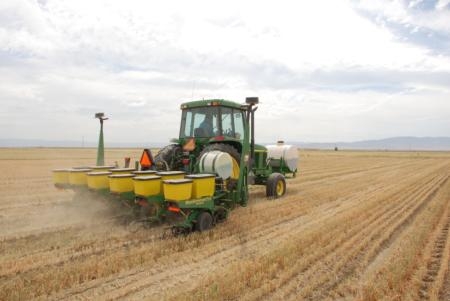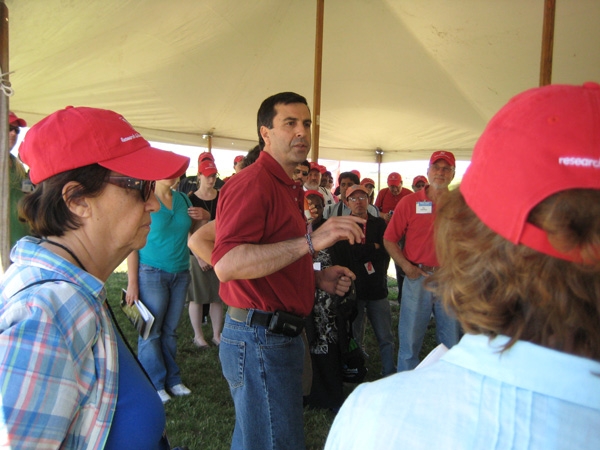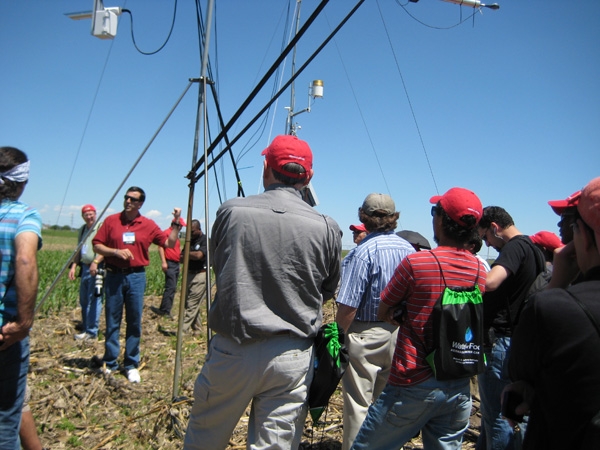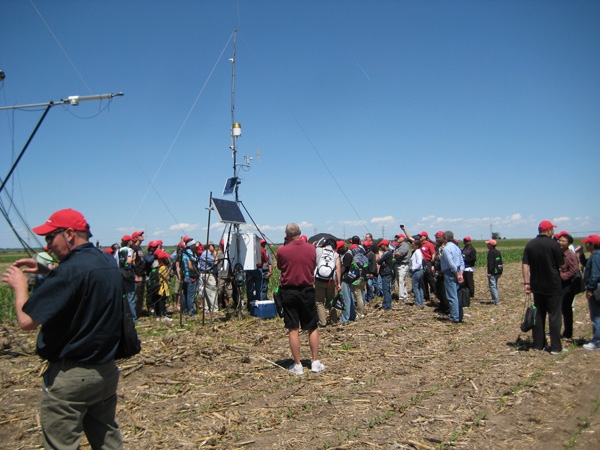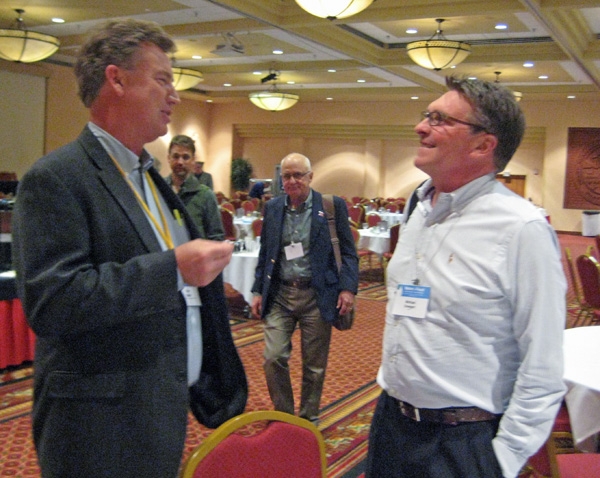Conservation agriculture news
Six-part conservation agriculture documentary premieres Aug. 6
The San Joaquin Valley boasts many of America’s most innovative farms. However, in terms of conservation agriculture practices – such as using little or no tillage, maintaining crop residues on the soil surface, and irrigating with buried drip or overhead systems – the most important agricultural region in the world is lagging behind.
To introduce more valley farmers to the benefits of conservation agriculture practices, Conservation Agriculture Systems Innovation (CASI) produced a six-part documentary featuring California farmers, UC researchers and agency representatives. The series premieres Aug. 6 on the CASI website (http://CASI.ucanr.edu) with a 7-minute segment that lays out the theoretical principles and the scientific basis for conservation agriculture. Additional segments will be released each Monday for five weeks thereafter.
Throughout the series, viewers will meet farmers who are implementing conservation agriculture successfully and profitably on their Central Valley farms. The 6- to 10-minute episodes review the core principles and practices associated with conservation agriculture systems and provide examples of successful local adoption.
After the six-week series airs, viewers, farmers and others interested in conservation agriculture are invited to the UC West Side Research and Extension Center in Fresno County for the annual Twilight Conservation Agriculture Field Day, Sept. 13. The event, which begins at 4 p.m. and concludes when darkness falls, is free and includes a barbecue dinner. Viewers can get clarification on points from the video series and meet many of the farmers and scientists featured in the documentary, plus get a first-hand look at conservation agriculture research currently under way.
To register for the Twilight Field Day go to http://ucanr.edu/TwilightRegistration. The West Side Research and Extension Center is at 17353 W. Oakland Ave., Five Points.
“Our goal with the video series is to reach a wider audience of farmers with our research results and on-farm success stories, which show conservation agricultural practices can help make farmers more competitive and sustainable in the long run,” said Jeff Mitchell, UC Cooperative Extension specialist in the Department of Plant Sciences at UC Davis.
The Conservation Agriculture Systems Innovation documentary series includes the following episodes:
Aug. 6: “Introduction to conservation agriculture” – The first video defines conservation agriculture and outlines its increasing credibility in the global context.
Aug. 13: “Maintaining crop residues” – California farmers have tended to adopt “clean cultivation” systems, but research has shown that maintenance of residues from the previous crop or a winter cover crop helps improve soil and reduces evaporation from the surface.
Aug. 20: “Conservation agriculture in tomato production systems” – These systems cut production costs, reduce dust emissions and store more carbon in the soil.
Aug. 27: “Conservation agriculture in dairy silage production systems” – Three dairy farmers committed to conservation agriculture systems in their silage production share their secrets and success.
Sep. 3: “Minimum tillage systems” – This video features examples of a number of reduced pass or ‘pass combining’ tillage systems that have been developed during the past decade.
Sep. 10: “Coupling conservation tillage with overhead irrigation” – Overhead irrigation systems, such as center pivots, are particularly useful when coupled with conservation tillage.
For more information, contact Mitchell at (559) 303-9689 or jpmitchell@ucdavis.edu.
Low-till forage production on dairies
To fill their need for year-round, inexpensive forages, California dairy producers typically plant and harvest a series of forage crops – small grains, corn for silage, milo and sorghum sudan.
While this requires considerable tillage and seed-bed preparation ahead of each successive crop, the production systems lend themselves to conservation tillage approaches developed in other regions. Adopting these approaches could:
- Reduce the time between the harvest of one crop and the planting of the next
- Lower costs
- Lessen dust by as much as two-thirds
To address these issues, Jeff Mitchell, UC Cooperative Extension advisor in the UC Davis Department of Plant Sciences, was awarded a Western SARE Professional + Producer Grant for $9,400 to evaluate and refine strip-till and no-till planting systems for corn forage production and no-till drill winter forage planting at the San Joaquin Valley in terms of crop establishment, weed control and profitability (Conservation Tillage Forage Production in California‘s San Joaquin Valley, FW06-308).
The work, conducted on the Larry and Daniel Soares dairy in Hanford, also sought to determine whether conservation tillage practices could enhance the quality of life of dairy producers as measured by profitability and the easing of time and labor requirements.
The project team evaluated strip-till silage corn production following wheat for-age at the 600-cow dairy. In 2006, the trials evaluated conventional, no-till and strip-till in replicated strips, each 10 acres, in an 80-acre field. After the 2005-06 winter wheat forage crop was chopped in April 2006, a 6-row 30-inch Case DMI Ecolo-Till strip-tiller was used to subsoil to 12 inches and clear soil for planting. The traditional tillage strips were disked and listed before planting.
In 2007, because of irrigation pump challenges, the demonstration was moved to two fields, where an 8-row 30-inch Schlagel strip-tiller was used for the strip-till comparison.
The results for 2006 were compromised by irrigation challenges, but in the 2007 demonstration, corn plant populations were higher in the strip-tilled fields, and weed populations and yields were roughly equal in both fields.
On the whole, said Mitchell, the results were positive and encouraging.
Indeed, since the project started in 2005, interest in conservation tillage has increased markedly in the San Joaquin Valley. Growers have learned that strip-tillage involves less intercrop tillage than normally employed following winter wheat chopping in preparation for spring corn silage planting.
By converting to strip-tillage, a typical dairy producer could eliminate four to five tractor passes. With high fuel costs, fewer passes across the field are better not only for the field but also for the dairy producer.
It has also been shown that strip-tillage and no-tillage for forage production can reduce particulate matter emissions by 50-90% compared with traditional tillage.
“We estimate a reduction in costs of $50 an acre by using strip-tillage instead of traditional tillage,” said Mitchell. “However, it is important to understand that strip-tillage may not work in all soil types; heavier soils may be more difficult than coarser soils.”
Mitchell offers these thoughts for producers considering strip-tillage:
- When strip-tilling, having some moisture in the soil precludes bringing up large clods
- Timely weed management is needed – time herbicide applications close to planting (within a week)
- Using the same GPS system for both the strip-tilling and planting operations will keep the planter on the strip-tilled area
Improved strip-tilling could enable triple-cropping – the sequential growing of three crops in a year – which could help San Joaquin dairy producers manage manure nitrogen with minimal risk of losses. Mitchell is currently assessing this in a Western SARE Research and Education Grant, Triple-Cropping Dairy Forage Production Systems through Conservation Tillage in California‘s San Joaquin Valley (SW08-060).
Want more information? See the related SARE grant(s) FW06-308, Conservation Tillage Forage Production in California‘s San Joaquin Valley, and SW08-060, Triple-Cropping Dairy Forage Production Systems through Conservation Tillage in California‘s San Joaquin Valley.
Source: Western SARE From the Field Profile
Water for Food participants visit Nebraska research center
The University of Nebraska, Lincoln, hosted a group of Water for Food Conference participants on a tour of the UNL South Central Ag Laboratory in Clay Center, Neb., June 2. At the 640-acre facility, research aims to develop and refine irrigated crop production practices for Nebraska agriculture.
Many of the ag practices being studied at the center parallel work being conducted at the University of California's West Side Research and Extension Center in Five Points. Field projects at the Clay Center facility include corn produced using conservation tillage practices and irrigated with subsurface drip and overhead systems.
UNL professor of biological systems engineering Suat Irmak hosted the tour. Irmak leads the Nebraska Agricultural Water Network, in which 900 Nebraska farmers are involved in an effort to increase adoption of new tools, technologies and strategies for increasing crop water productivity and reducing energy use in agriculture.
Insight and optimism as the Water for Food Conference wraps up
Scientists described highly technical basic research at the plant genome level to develop crops that produce sufficient yield, even under drought conditions. Policymakers compared notes on innovative water governance strategies. Farmers talked about implementing high-efficiency irrigation and tillage techniques. University researchers outlined efforts to fine-tune crop production systems. People from the four corners of the earth shared novel ways - like reducing food waste and moving away from water-intensive diets - to achieve a common goal.
During the final panel session on Friday, interim director of the Nebraska Water Center at the University of Nebraska, Lincoln, Suet Irmak, said that, in addition to finding solutions, in order to close the gap in food need, education and extension are critical.
"Somebody has to take the research to the farm. That will make the real impact on the ground," Irmak said.
Dan Munk, University of California Cooperative Extension advisor in Fresno County, agreed. Munk, a water and soils expert, was one of seven members of a California delegation that attended the conference for the first time. As far as California farmers have come in terms of water management, he said, there are still efficiency gains to be made by increasing soil moisture monitoring, improving irrigation systems and refining the way irrigation systems are managed.
"We are seeing more and more farmers (in California) use soil moisture sensors, measure crop stress, meter water and switch over to pressurized irrigation systems like drip, micro sprinklers and overhead systems," Munk said. But more must be done.
Munk is a member of the executive board for Conservation Agriculture Systems Innovation (CASI), which is seeking to further promote improved crop production and irrigation systems throughout the state.
During the closing panel on Friday, Simi Kamal, chair of the Hisaar Foundation in Pakistan, said that the global nature of the Water for Food Conference has revealed similarities among the diverse partipants and new ways for people to work together.
"At the 'Women, Water and Food' panel discussion, we concluded that there is a common thread," Kamal said. "All we have to do is pick it up and stitch it together."
California can learn from Nebraska's irrigation technology success
Conservation Agriculture Systems Innovation (CASI) has a vision for California – a vision in which farmers make more money while using less water and protecting the environment. However, the organization has been frustrated that the progress in getting these ag systems adopted by farmers has been rather slow. A member of the CASI executive board and a project director with the California Association of Resource Conservation Districts, Ron Harben, brought up the point with a panel of industry experts at the Water for Food Conference in Lincoln, Neb., May 31.

